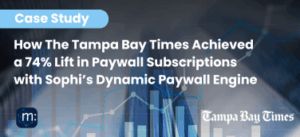By Guest Contributor: Lennart Schneider, Strategy Consultant, Podcast Host and Newsletter Editor at Subscribe Now and Katherine Ruane, Director of Strategic Marketing at Mather
March 14th, 2025
Meet Lennart Schneider: Newsletter Pro, Engagement Strategist & Subscriptions Growth Expert
1. From your time at DIE ZEIT to launching Subscribe Now, you’ve been deeply involved in subscription growth and audience engagement. What inspired you to start this platform, and what key lessons have shaped your approach?
I like subscription models because they focus on building long-term, trusting customer relationships. That’s why the subtitle of my podcast is "How to win subscribers and keep them happy." When we developed the membership program Friends of ZEIT, we sought inspiration from other industries on how they nurture customer relationships. When I became self-employed as a consultant in 2022, I wanted to continue this research and used the podcast as a way to speak with the brightest minds in the subscription economy and learn from them.
2. What’s your media diet like? How many media outlets or platforms do you subscribe to—and do you have a favorite?
I listen to podcasts for several hours a day and subscribe to over 3,000 newsletters—these are my main sources of inspiration. My top podcasts include Lenny's Podcast, Decoder, Vergecast, Pivot, Channels, The Rebooting Show, A Newsletter Operator, The Hustle, and many more. For newsletters, I read turi2 for German industry news and Axios Media and AI+ for international topics. Additionally, I follow The Fix, Semafor Media & Technology, Growth in Reverse, Send & Grow, Techpresso, Nieman Lab, and many others.
The Secret Ingredient: Community & Engagement
1. Through Subscribe Now, you’ve built a thriving community. What’s your approach to audience development, and how do you turn readers into long-term, loyal subscribers?
I focus on three channels: LinkedIn, my podcast, and my newsletter. Additionally, I attend events where I give talks and network. These channels complement each other well—LinkedIn helps people discover my content, while the podcast and newsletter allow them to explore it in more depth. What’s important to me is no bullshit. I don’t want to sell "10 tricks to gain 10,000 followers in 3 minutes" but rather share real, experience-based insights. Through consulting, I’ve learned that there are no silver bullets—every company is unique.
This approach may not lead to rapid growth, but it builds trust in the long run.
2. Have you come across any standout community-driven strategies that have led to success in the industry recently?
I closely observe the B2B sector, where two high-priced trends are emerging: professional briefings with newsletters costing €200 per month and communities like the Handelsblatt Circles or the Axios Media Trends Executive Membership.
These focus on small niches where networking and information deliver a high ROI. I believe that without specialization and a clear added value, it will be difficult to stand out in the oversupply of information and entertainment.
Growing the Subscriber Base: Acquisition Strategies That Work
1.How are publishers evolving their approach to subscriber-only content and paywalls? Are you seeing new strategies that are particularly effective in driving growth?
I am noticing more and more collaborations and super bundles. The tabloid newspaper BILD sells its subscription together with Amazon Prime, and the Frankfurter Allgemeine Zeitung offers a bundle with the New York Times. If you can find complementary partners who offer attractive content for your target audience, it can enhance your appeal. Additionally, people already have so many subscriptions, and if they can bundle several from one source while saving money, it makes their lives easier.
2. Have you observed any major differences in how European publishers approach introductory offers and trials compared to the other regions?
Dynamic paywalls are already more widespread internationally but are now also making their way into Germany. Additionally, I believe that registration walls will increasingly become a common precursor to subscriptions in the future. The flexible and user-specific approach of The New York Times serves as a model for many, but often the technology required for this level of personalization is still lacking.
3. Do you see micropayments and alternative pricing models as a game-changer for the industry, or do they still largely remain a niche strategy?
I believe dynamic paywalls will, in the future, enable the identification of users unwilling to subscribe and offer them alternatives. Startups like Tiun are already working on this. For example, the Kölner Stadt-Anzeiger sells coins for individual articles, and Stiftung Warentest offers single tests for €4.90. For most publishers, however, subscriptions will remain the first choice, making it crucial to carefully determine to whom and when alternatives should be offered.
Retention & Personalization: Keeping Subscribers Hooked
1. How are European publishers striking a balance between respecting user privacy and delivering personalized experiences?
To be honest, most publishers still offer very little personalization. This is partly due to strict GDPR regulations but also because of the journalistic principle that editorial teams should decide which topics are important, as well as users’ desire to avoid getting trapped in filter bubbles.
Unlike social media, publishers often have a mission to inform people about topics beyond their immediate interests.
2. Newsletters have become a powerful tool for media brands. How do they work best alongside personalized content? Any lessons from your own newsletter?
Newsletters should be seen as an editorial format, not merely an advertising channel designed to drive traffic to a website. Those who optimize their newsletters solely for clicks are missing their full potential. There are fantastic newsletters that people read word for word, feeling satisfied at the end—even without clicking a single link.
More important than a high click rate is ensuring that readers come back the next day and the day after that, recognizing that your newsletter consistently provides valuable insights. And, of course, the business model must align with this: publishers who sell native newsletter ads or incorporate freemium newsletters monetize all readers—not just those who encounter the paywall on the website.
3. Bundling is often seen as a way to boost retention by increasing engagement and perceived value. In your experience, what makes a subscription bundle truly effective, and are there any pitfalls publishers should watch out for?
I believe it’s important to define the goal of the bundle: Is it meant to acquire more customers, serve as an upsell to increase ARPU, or boost engagement to improve retention? Depending on the goal, the bundle plays a different role in the user journey:
- A bundle for acquisition needs to be a no-brainer. If customers are unfamiliar with the second product, it can actually deter them from purchasing. That’s why The New York Times and Amazon Prime make great bundle components—everyone knows what they’re getting.
- A bundle for upselling must clearly communicate its added value and is primarily targeted at highly engaged customers who may be willing to pay more.
- A bundle for engagement needs to build habits. This means regularly drawing attention to it and ensuring a seamless user experience that guides users toward the bundled content.
The biggest risk is that users feel they are overpaying for content they don’t need.
Looking Ahead: What’s Next for Subscription Models?
1. As we look ahead to 2025 and beyond, what do you see as the biggest trend shaping how European media companies approach subscriptions? Are there any emerging technologies or innovations that you believe will have a major impact on how publishers operate and engage with audiences?
I believe that offerings are becoming increasingly differentiated. Until now, most providers have had a one-size-fits-all subscription model. This made sense in recent years because digital subscriptions were new, and it helped reduce complexity. The priority was to gain as many subscribers as possible, regardless of whether the price perfectly matched their willingness to pay.
In the coming years, we will see more offerings designed to provide the right subscription at the right price for everyone. That’s why Netflix, Disney, and Amazon Prime are focusing on affordable ad-supported models for the mass market and ad-free models for a premium audience. We’re seeing something similar with publishers, who are exploring ways to better cater to both the upper and lower ends of their target audience.
To learn more about Lennart and his content, visit his website at Subscribe Now. For inquiries or to connect, feel free to check out his LinkedIn profile.
Read More Insights




